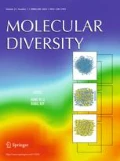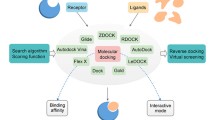Abstract
The present study describes a systematic 3D-QSAR study consisting of pharmacophore modeling, docking, and integration of ligand-based and structure-based drug design approaches, applied on a dataset of 72 Hsp90 inhibitors as anti-cancer agents. The best pharmacophore model, with one H-bond donor (HBD), one H-bond acceptor (HBA), one hydrophobic_aromatic (Hy_Ar), and two hydrophobic_aliphatic (Hy_Al) features, was developed using the Catalyst/HypoGen algorithm on a training set of 35 compounds. The model was further validated using test set, external set, Fisher’s randomization method, and ability of the pharmacophoric features to complement the active site amino acids. Docking analysis was performed using Hsp90 chaperone (PDB-Id: 1uyf) along with water molecules reported to be crucial for binding and catalysis (Sgobba et al. ChemMedChem 4:1399–1409, 2009). Furthermore, an integration of the ligand-based as well as structure-based drug design approaches was done leading to the integrated model, which was found to be superior over the best pharmacophore model in terms of its predictive ability on internal [integrated model 2: R (train) = 0.954, R (test) = 0.888; Hypo-01: R (train) = 0.912 and R (test) = 0.819] as well as on external data set [integrated model 2: R (ext.set) = 0.801; Hypo-01: R (ext.set) = 0.604].
Similar content being viewed by others
Abbreviations
- Hsp90:
-
Heat shock protein 90
- CADD:
-
Computer-aided drug design
- VS:
-
Virtual screening
- PBVS:
-
Pharmacophore-based VS
- SBVS:
-
Structure-based VS
References
Pearl LH (2005) Hsp90 and Cdc37—a chaperone cancer conspiracy. Curr Opin Genet DeV 15: 55–61. doi:10.1016/j.gde.2004.12.011
Powers MV, Workman P (2007) Inhibitors of the heat shock response: biology and pharmacology. FEBS Lett 581: 3758–3769. doi:10.1016/j.febslet.2007.05.040
Soldano K L, Jivan A, Nicchitta CV, Gewirth DT (2003) Structure of the N-terminal domain of GRP94: basis for ligand specificity and regulation. J Biol Chem 278: 48330–48338. doi:10.1074/jbc.M308661200
Miriam S, Giulio R. (2009) Structure-based and in-silico design of Hsp90 inhibitors. ChemMedChem 4: 1399–1409. doi:10.1002/cmdc.200900256
Lipinski CA, Lombardo F, Dominy BW, Feeney PJ (1997) Experimental and computational approaches to estimate solubility and permeability in drug discovery and development settings. Adv Drug Delivery Rev 23: 3–25. doi:10.1016/S0169-409X(96)00423-1
Xue L, Stahura FL, Bajorath J (2004) Similarity search profiling reveals effects of fingerprint scaling in virtual screening. J Chem Inf Comput Sci 44: 2032–2039. doi:10.1021/ci0400819
Srinivasan J, Castellino A, Bradley EK, Eksterowicz JE, Grootenhuis PDJ, Putta S, Stanton RV (2002) Evaluation of a novel shape-based computational filter for lead evolution application to thrombin inhibitors. J Med Chem 45: 2494–2500. doi:10.1021/jm010494q
Prathipati P, Pandey G, Saxena AK (2005) CoMFA and docking studies on glycogen phosphorylase a inhibitors as antidiabetic Agents. J Chem Inf Model 45: 136–145. doi:10.1021/ci049762u
Sun H (2008) Pharmacophore-based virtual screening. Curr Med Chem 15: 1018–1024. doi:10.2174/092986708784049630
Leach AR, Shoichet BK, Peishoff CE (2006) Prediction of protein-ligand interactions. docking and scoring: successes and gaps. J Med Chem 49: 5851–5855. doi:10.1021/jm060999m
Nicolotti O, Miscioscia TF, Carotti A, Leonetti F, Carotti A (2008) An integrated approach to ligand- and structure-based drug design: development and application to a series of serine protease inhibitors. J Chem Inf Model 48: 1211–1226. doi:10.1021/ci800015s
Knox AJS, Price T, Pawlak M, Golfis G, Flood CT, Fayne D, Williams DC, Meegan MJ, Lloyd DJ (2009) Integration of ligand and structure-based virtual screening for the identification of the first dual targeting agent for heat shock protein 90 (Hsp90) and tubulin. J Med Chem 52: 2177–2180. doi:10.1021/jm801569z
Sugunadevi S, Sundarapandian T, Shalini J, Yong JK, Keun WL (2010) 3D QSAR pharmacophore based virtual screening and molecular docking for identification of potential HSP90 inhibitors. Eu J Med Chem 45: 2132–2140. doi:10.1016/j.ejmech.2010.01.016
Accelrys Inc (2002) Catalyst, version 4.7. Accelrys, Inc., San Diego, CA
Venkatachalam CM, Jiang X, Oldfield T, Waldman M (2003) LigandFit: a novel method for the shape-directed rapid docking of ligands to protein active sites. J Mol Graph Model 21: 289–307. doi:10.1016/S1093-3263(02)00164-X
Accelrys Software Inc (2001) Discovery studio software, version 2.0. Accelrys Software Inc., San Diego, CA (2001)
Jones G, Willett P, Glen RC, Leach AR, Taylor R (1997) Development and validation of a genetic algorithm for flexible docking. J Mol Biol 267: 727–748. doi:10.1006/jmbi.1996.0897
Schrödinger LLC (2008) Glide, version 5.0. Schrödinger, LLC, New York, NY
Greenwood JR, Halgren TA, Sanschagrin PC, Mainz DT (2006) Extra precision glide: docking and scoring incorporating a model of hydrophobic enclosure for protein-ligand complexes. J Med Chem 49: 6177–6196. doi:10.1021/jm051256o
Schrödinger LLC (2005) Schrödinger software, version 8.0. Schrödinger LLC, New York, NY
Todeschini R, Consonni V (2001) Dragon software (version 1.11). Milano Chemometrics and QSAR Research group, Talete, Milano, Italy
Systat, SPSS Inc., 444 North Michigan Avenue, Chicago, IL 60611, USA
Llauger L, He H, Kim J, Aguirre J, Rosen N, Peters U, Davies P, Chiosis G (2005) Evaluation of 8-arylsulfanyl, 8-arylsulfoxyl, and 8-arylsulfonyl adenine derivatives as inhibitors of the heat shock protein 90. J Med Chem 48: 2892–2905. doi:10.1021/jm049012b
Li H, Sutter J, Hoffman R (1999) HypoGen: an automated system for generating 3D predictive pharmacophore models. In: Guner OF (ed) Pharmacophore perception, development, and use in drug design. International University Line, La Jolla, CA
Kurogi Y, Güner OF (2001) Pharmacophore modeling and three-dimensional database searching for drug design using catalyst. Curr Med Chem 8: 1035–1055. doi:10.2174/0929867013372481
Sprague PW (1995) Automated chemical hypothesis generation and database searching with Catalyst. In: Müller K (ed) Perspectives in drug discovery and design. ESCOM Science Publishers BV, Leiden, Netherlands
Brooks BR, Bruccoleri RE, Olafson BD, States DJ, Swaminathan S, Karplus M (1983) CharmM: a program for macromolecular energy, minimization, and dynamics calculations. J Comput Chem 4: 187–217. doi:10.1002/jcc.540040211
Sutter J, Güner, Hoffman R, Li H, Waldman M (1999) Effect of variable weight and tolerances on predictive model generation. In: Güner OF (ed) Pharmacophore perception, development, and use in drug design. International University Line, La Jolla, CA
Eldridge MD, Murray CW, Auton TR, Paolini GV, Mee RP (1997) Empirical scoring functions: I. The development of a fast empirical scoring function to estimate the binding affinity of ligands in receptor complexes. J Comput Aided Mol Des 11: 425–445. doi:10.1023/A:1007996124545
Krammer A, Kirchhoff PD, Jiang X, Venkatachalam CM, Waldman M (2005) LigScore: a novel scoring function for predicting binding affinities. J Mol Graph Model 23: 395–407. doi:10.1016/j.jmgm.2004.11.007
Böhm HJ (1998) Prediction of binding constants of protein ligands: a fast method for the prioritization of hits obtained from de novo design or 3D database search programs. J Comput Aided Mol Des 12: 309–323. doi:10.1023/A:1007999920146
Muegge I, Martin YC (1999) A general and fast scoring function for protein-ligand interactions: a simplified potential approach. J Med Chem 42: 791–804. doi:10.1021/jm980536j
Muegge I (2006) PMF scoring revisited. J Med Chem 49: 5895–5902. doi:10.1021/jm050038s
Cheng T, Li X, Li Y, Liu Z, Wang R (2009) Comparative assessment of scoring functions on a diverse test set. J Chem Inf Model 49: 1079–1093. doi:10.1021/ci9000053
Jain AN (1996) Scoring non-covalent protein-ligand interactions: a continuous differentiable function tuned to compute binding affinities. J Comput Aided Mol Des 10: 427–440. doi:10.1007/BF00124474
Wright L, Barril X, Dymock B, Sheridan L, Surgenor A, Beswick M, Drysdale M, Collier A, Massey A, Davies N, Fink A, Fromont C, Aherne W, Boxall K, Sharp S, Workman P, Hubbard RE (2004) Structure–activity relationships in purine-based inhibitor binding to Hsp90 isoforms. Chem Biol 11: 775–785. doi:10.1016/j.chembiol.2004.03.033
Liu T, Lin Y, Wen X, Jorissen RN, Gilson MK (2007) BindingDB: a web-accessible database of experimentally determined protein–ligand binding affinities. Nucl Acids Res 35: D198–D201. doi:10.1093/nar/gkl999
Author information
Authors and Affiliations
Corresponding author
Electronic Supplementary Material
Rights and permissions
About this article
Cite this article
Roy, K.K., Singh, S. & Saxena, A.K. Integration-mediated prediction enrichment of quantitative model for Hsp90 inhibitors as anti-cancer agents: 3D-QSAR study. Mol Divers 15, 477–489 (2011). https://doi.org/10.1007/s11030-010-9269-y
Received:
Accepted:
Published:
Issue Date:
DOI: https://doi.org/10.1007/s11030-010-9269-y




